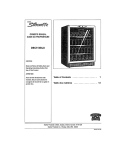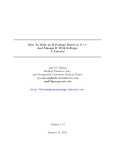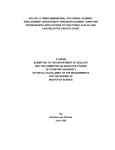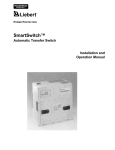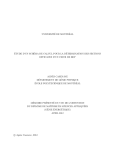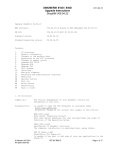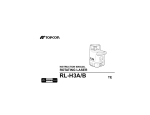Download GenPMAXS-v3 - Purdue University
Transcript
PU/NE-00-20 (Rev. 4) DRAFT 11/01/04 GenPMAXS Code for Generating the PARCS Cross Section Interface File PMAXS T. Downar Y. Xu Purdue University School of Nuclear Engineering November, 2004 i PU/NE-00-20 (Rev. 4) ABSTRACT The Purdue Macroscopic cross section, XS (PMAXS) was developed in order to provide an interface between lattice physics codes and the PARCS. PMAXS provides the principal macroscopic cross sections, the microscopic cross sections of Xe/Sm, and the group-wise form functions with several different branch states for the appropriate fuel burnup states. The GenPMAXS program (Generation of the Purdue Macroscopic XS set) was written specifically to generate the PMAXS file from other macroscopic cross section libraries and the results of any lattice code, such as HELIOS, TRITON, and CASMO. This manual describes the representation of the cross sections and major methodologies employed in the PMAXS format, as well as input data for the GenPMAXS code and the results of the some benchmark problems. 2 PU/NE-00-20 (Rev. 4) TABLE OF CONTENTS ABSTRACT........................................................................................................................ 2 LIST OF TABLES.............................................................................................................. 5 LIST OF FIGURES ............................................................................................................ 6 1. Introduction..................................................................................................................... 7 1.1. Purpose..................................................................................................................... 7 1.2. Overview.................................................................................................................. 7 2. Purdue Macroscopic Cross Section file, PMAXS .......................................................... 9 2.1. Cross Section Representation .................................................................................. 9 2.2. PMAXS Content .................................................................................................... 11 2.3. Procedures for generating cross section data in all branches................................. 12 2.3.1 Reference Branch............................................................................................. 12 2.3.2 Control Rod Branches...................................................................................... 12 2.3.3 Moderator Density Branches ........................................................................... 12 2.3.4 Soluble Boron Branches .................................................................................. 13 2.3.5 Fuel Temperature Branches ............................................................................. 13 2.3.6 Moderator Temperature Branches ................................................................... 13 2.4. Tree structure and linear interpolation between branches ..................................... 14 2.5. Tree structure and linear interpolation for history states ....................................... 16 3. Special treatments for cross sections in GenPMAXS................................................... 18 3.1. Scattering Cross Sections Treatment in the GENPMAXS Code........................... 18 3.2 Generation of Reflector Cross Sections.................................................................. 18 4. The GenPMAXS Code ................................................................................................. 24 4.1. Introduction to the GenPMAXS Code................................................................... 24 4.2. GenPMAXS Code Structure .................................................................................. 24 5. Generate PMAXS from results of HELIOS.................................................................. 25 5.1. Introduction............................................................................................................ 25 5.2. HELIOS Input Concept.......................................................................................... 25 5.3. Cross-section Definitions....................................................................................... 28 5.3.1. The Effective Xenon/Samarium Yield............................................................ 28 5.3.2. Delayed neutron data ..................................................................................... 29 5.3.3. Form Function for Pin Power Reconstruction ................................................ 30 5.4 The ZENITH Output Keywords for the GenPMAXS Code............................... 31 5.5. HELIOS-to-PMAXS Code Structure..................................................................... 33 6. Benchmark .................................................................................................................... 34 6.1. Benchmark 1: Generate PMAXS from HELIOS calculation ................................ 34 APPENDIX A PMAXS and XSEC Format...................................................................... 38 1) XS Control Information........................................................................................ 39 2) Branches information ........................................................................................... 39 3) Burnup information .............................................................................................. 40 4) XS Set identification............................................................................................. 40 5) History case identification .................................................................................... 41 6) T/H invariant variable block................................................................................. 41 7) State identification................................................................................................ 42 8) XS data block........................................................................................................ 42 Appendix B Input Manual of GenPMAXS....................................................................... 44 3 PU/NE-00-20 (Rev. 4) 1. Input Description .......................................................................................................... 44 1.1. JOB_TITLE ........................................................................................................... 44 1.2. JOB_OPTION........................................................................................................ 45 1.3. DAT_SRC.............................................................................................................. 46 1.4. HEL_FMT.............................................................................................................. 46 1.5. BRANCHES .......................................................................................................... 47 1.6. STATE ................................................................................................................... 47 1.7. SCT_FAC .............................................................................................................. 48 2. The Samples input of GenPMAXS code ...................................................................... 49 2.1. The Sample Input for HELIOS .............................................................................. 49 2.2. The Sample Input for convert raw cross section to partials................................... 49 2.3.The Sample Input for convert from old format to new format PMAXS ................ 49 2.4.The Sample Input for generate corner reflector cross section ................................ 50 4 PU/NE-00-20 (Rev. 4) LIST OF TABLES Table 2.1 Parametrics for Cross Section Dependence Study............................................ 10 Table 2.2. Variation (%) of Kinf and its Partial Derivative for Each Variable ................ 11 Table 2.3. Dependencies of Kinf and its Partial Derivative to Each Variable................. 11 Table 5.1. Recommended Decay Constants (/sec)............................................................ 29 Table 5.2. Delayed Neutron Yield Data............................................................................ 30 Table 5.3. Delayed Neutron Decay Constant (1/sec)........................................................ 30 Table 6.1. Reference and branches states ......................................................................... 34 5 PU/NE-00-20 (Rev. 4) LIST OF FIGURES Figure 1.1 Overview of PARCS package for core depletion analysis................................ 8 Figure 2.1 Example of Branch Cases in PMAXS............................................................. 14 Figure 2.2 Example of computing XS at point 1 .............................................................. 16 Figure 2.3 Multi-dimensional Linear Interpolation for History States ............................. 17 Figure 3.1. Reflector Models ........................................................................................... 19 Figure 4.1. Overall Flow in GenPMAXS ......................................................................... 24 Figure 5.1 Overview of HELIOS Code ............................................................................ 27 Figure 5.2 Flow Diagram of AURORA, HELIOS and ZENITH code............................. 27 Figure 5.3. Code structure of HELIOS-to-PMAXS.......................................................... 33 Figure 6.1. PARCS model for benchmark problems ........................................................ 34 Figure 6.2. BWR assembly in benchmark1 ...................................................................... 35 Figure 6.3. PARCS and HELIOS K-inf for BWR assembly in benchmark1 .................. 36 Figure 6.4. PARCS and HELIOS K-inf difference for BWR assembly in benchmark1 .. 37 6 PU/NE-00-20 (Rev. 4) 1. Introduction 1.1. Purpose This manual describes the theory and procedure for generating PMAXS (Purdue Macroscopic cross section, XS) files which can be used by PARCS1) (Purdue Advanced Reactor Core Simulator) for core depletion analysis. The original PARCS cross section model which utilizes the XSEC block in the PARCS input has been retained as the default option. The new model described here uses PMAXS in lieu of XSEC and is initiated using 2 new cards in the PARCS CNTL input block (TREEXS and DEPLETION). This manual provides a detailed description of the methods for generating cross sections and the procedures used to execute the GenPMAXS/PARCS code sequence to perform core depletion analysis. 1.2. Overview PARCS is a neutronics code for the prediction of nuclear reactor core transient behavior at a specific core burnup state. PARCS solves the time-dependent neutron diffusion and SP3 transport equations in three-dimensional geometry to obtain the neutron flux distribution. Since PARCS is capable of performing core eigenvalue calculations, as well as such functions as analyzing the control rod movement and searching for the critical boron concentrations, it possesses the functionality necessary to analyze both short term (kinetic) and longer term (depletion) core behavior. In order to provide depletion capability to the PARCS code, a depletion module was added to PARCS. A new cross section module was also added to PARCS to retrieving node-wise cross section for its burunp history and current thermal-hydraulic state from PMAXS. The overview of PARCS package for core depletion analysis is shown in figure 1.1. As indicated in the Figure, two codes are used to perform core depletion: a depletion code (DEPLETOR), and PARCS. The depletion code generates the cross-sections of the new burnup state and PARCS solves the diffusion equations with the given cross sections. The cross sections generated by the depletion code are transferred to PARCS and the neutron power distribution generated by PARCS is transferred back to the depletion code. Currently, PARCS employs a macroscopic depletion method in which the microscopic cross sections and fuel number densities are not tracked individually during core depletion. Only the macroscopic cross sections are transferred between DEPLETOR and the PARCS code. The fuel macroscopic cross sections at the appropriate fuel conditions are prepared using any lattice physics code such as HELIOS3), CASMO4), etc. The PMAXS code is constructed using the output of the lattice code and provides the cross section data in the specific format that can be read by the macroscopic depletion code DEPLETOR. Because the output format of the each lattice code is unique, the cross section processing program, GENPMAXS, was written to process the output of the lattice codes and prepare the PMAXS formatted cross section. An overview of the cross section generation scheme is shown in Figure 1.2. The GENPMAXS (Generation of the Purdue XS set) code is therefore the interface between the lattice code and the depletion 7 PU/NE-00-20 (Rev. 4) code. It processes the output of the lattice code and generates the PMAXS formatted files. More detailed guidelines for execution the GENPMAXS/DEPLETOR/PARCS code system are provided in Appendix E. Lattice code Output files GenPMAX PMAXS T/H Code Node-wise Power DEPLETION Module PARCS History for each region Cross Section Module TRACE or RELAP5 Neutronics Calculation Node-wise Cross Section T/H state Figure 1.1 Overview of PARCS package for core depletion analysis 8 PU/NE-00-20 (Rev. 4) 2. Purdue Macroscopic Cross Section file, PMAXS 2.1. Cross Section Representation PMAXS is structured in a macroscopic cross section format to be read by the PARCS depletion routine. It has been developed for representation of the macroscopic K cross sections as a function of the state variables, such as the control rod poison ( α ), moderator density (Dm), soluble boron concentration (Sb), fuel temperature (Tf), moderator temperature (Tm), and burnup ( B ). Since the macroscopic cross sections are strongly dependent on history effects, especially for the BWR, up to two history variables (H1,H2) have also been introduced in the most recent version of the PMAXS format. The two history variables can be any combination of control rod history (HCR), moderator density history (HMD), Soluble Boron history (HSB), fuel temperature history (HTF) or moderator density history. Two history variables together with the fuel burnup K determines the history state, H = ( B, H 1, H 2) . Because the absorption cross sections of Xenon and Samarium are considerably larger than other isotopes and are strongly dependent on the flux level of each node, the absorption cross sections of the Xenon and Samarium are represented by their microscopic cross sections and number densities. The typical representation form of the macroscopic cross section at a certain state is given by: K K K K K K l l Σ l (α , Dm, SB, Tf , Tm, H ) = Σ E ,l (α , Dm, SB, Tf , Tm, H ) + N Xe σ Xe (α , Dm, SB, Tf , Tm, H ) K K l l + N Sm σ Sm (α , Dm, SB, Tf , Tm, H ) (2.1) where Σ E is the macroscopic cross section, which does not include Xenon, Samarium The superscript l and the various subscripts denote the node index and isotope name respectively. To make use of these macroscopic cross sections in the depletion code, they must be determined systematically for each of the state variables. The macroscopic cross sections of in PARCS are constructed with the assumption of linear superposition of the partial cross sections on a base reference state. PMAXS supports all information which is required in representing macroscopic cross-sections using this approximation as: K K K ∂Σ K K Σ(α , Dm, Sb, Tf , Tm, H ) = Σ r ( H ) + ∑ α i ∆Σ i ( H ) + ∆Dm K ∂Dm (α , Dm m , H ) i + ∆Sb ∂Σ ∂Σ ∂Σ K K + ∆ Tf m K + ∆Tm K K K m ∂Sb (α , Dm, Sb , H ) ∂Tm (α , Dm, Sb, Tf , Tm m , H ) ∂ Tf (α , Dm, Sb, Tf , H ) (2.2) where a reference cross section Σ r (first term on the right hand side) is modified with contributions from the control rod insertion, ∆Σ i , moderator density, Dm, the boron concentration, Sb, the fuel temperature, Tf, and the moderator temperature, Tm. 9 PU/NE-00-20 (Rev. 4) For the control rod cross section contribution (second term on the right hand side), the partial cross section is provided simply as a perturbation of the cross section α i ∆Σ i . The weighting fraction, α , indicates the insertion fraction for each node and is provided K for each control rod type, i. In the equation above α is a vector with contents of each α i , since there are multiple control types in some BWR models (e.g. Ringhalls). If the α is flux weighted then the control rod effect is non-linear. If flux weighting is not available or not used, then the control rod effect is linear. Most all standard codes used in the industry (e.g. CASMO/SIMULATE) employ linear weighting [Reference: Simulate User Manual, SOA-92/02, p. 2-33] The contributions from the other independent variables (terms three, four, five, and six on the right hand side) are determined using the product of a partial cross section, ∂ Σ ∂x , and the amount of the perturbation for each independent variable: ∆Dm = Dm − Dm r ∆Sb = Sb − Sb r ∆Tf = Tf − Tf r ∆Tm = Tm − Tm r Dm m = ( Dm + Dm r ) / 2 = Dm r + ∆Dm / 2 Sb m = ( Sb + Sb r ) / 2 = Sb r + ∆Sb / 2 Tf m = (Tf + Tf r ) / 2 = Tf r + ∆Tf / 2 Tm m = (Tm + Tm r ) / 2 = Tm r + ∆Tm / 2 The superscript, m, denotes the midpoint of two data points in the pre-tabulated cross section data. This provides a second order accurate estimate of the cross section. The Partial cross sections are obtained by piecewise interpolation of the pre-tabulated data using a “tree structure”, which will be discuss in detail later in the document. The microscopic cross sections of Xenon and Samarium have same representation as Σ E and in (2.2) and hereafter, Σ represents both Σ E and the microscopic cross sections of Xenon and Samarium. The sequence of independent variables in equation 2.2 is fixed. It was established based on study in which a pin cell model was analyzed with each combination of the parameters shown in Table 2.1. Table 2.1 Parametrics for Cross Section Dependence Study Independent Variable Dm(g/cc) Sb(ppm) Tf ( K ) Tm(K) Low value Middle value High value 0.1 0 0.5 1000 30 0.9 2000 40 450 600 25 300 The partial derivatives of the cell k-infinite with respect to each independent variable were evaluated and the variations of the partial derivatives are shown in Table 2.2. The 10 PU/NE-00-20 (Rev. 4) dependency of the partial derivatives of the k-infinite with respect to each variable to all of the independent variables is summaried in Table 2.3. Table 2.2. Variation (%) of Kinf and its Partial Derivative for Each Variable Dm Sb Tf Tm Kinf ∂Kinf/∂Dm ∂Kinf/∂Sb 39.4 21.5 4.4 74 42 6 0.4 1 ∂Kinf/∂Tm 70 27 8 ∂Kinf/∂ Tf 24 24 8 148 127 70 2 2 196 Table 2.3. Dependencies of Kinf and its Partial Derivative to Each Variable Dm Sb Tf Tm Kinf ∂Kinf/∂Dm ∂Kinf/∂Sb Very strong strong Mild Very strong Strong Weak Very Strong Mild Weak Weak Almost none Almost none ∂Kinf/∂Tm ∂Kinf/∂ Tf Mild Mild Weak Very strong Very strong Strong Almost none Very Strong 2.2. PMAXS Content The PMAXS file contains all information which is required to implement Eq.(2.2). The cross section data, which includes the reference cross sections ( Σ r ), the cross section differences for the control rod states ( ∆Σ i ), and the partial derivatives of cross sections with respect to the feedback variables ( ∂Σ / ∂Dm , ∂Σ / ∂Sb , ∂Σ / ∂Tf , ∂Σ / ∂Tm ), are listed sequentially as branches in PMAXS. For each branch, the cross section data have a 3-dimensional structure for the history state variables dependencies. This will be described in detail in section 2.5. The PMAXS format was developed with several basic principles in mind. First, all information is provided in a hierarchical system. For example, the branch information is provided first and then the cross sections are provided sequentially for each branch. The second principle is that all information which is necessary to allocate computer memory is provided first and then followed by the cross sections. Thus, by reading the branch information, it is possible to know how many branch cases are stored in this particular PMAXS file and to allocate the required amount of memory. After processing this information for all cases, the cross sections for each branch of the fuel assembly are read sequentially. The detail structure of the PMAXS format is given in Appendix A. 11 PU/NE-00-20 (Rev. 4) 2.3. Procedures for generating cross section data in all branches This section will describe the methods used to treat the dependence of the instantaneous variable dependents. The method for treating history variables is described in section 2.5. The number or arrays in this section can be extended to 3 or more dimensions. In the treatment of the control rods it is assumed that a rod is either fully withdrawn or fully inserted in the fuel node. Flexibility is provided to treat different types of control rods and control rods with heterogeneous compositions. The variable (Cr) is used to represent the control rod states: K ⎧0, if α = 0 Cr = ⎨ ⎩i, if α i = 1 2.3.1 Reference Branch r The cross sections at the reference state ( Cr r , Dm r , Sb r , Tf , Tm r ) are directly stored in the reference branch. 2.3.2 Control Rod Branches r The states with reference parameters ( Dm r , Sb r , Tf , Tm r ) but control rods inserted are called control rod branches. The cross section differences between each control rod branch and the reference branch are computed and stored. r r ∆Σ i = Σ(Cr = i, Dm r , Sb r , Tf , Tm r ) − Σ r ( Dm r , Sb r , Tf , Tm r ) (2.3) The only instantaneous variable which control rod branches depend on is the control rod state (Cr). 2.3.3 Moderator Density Branches r The states with reference parameters ( Sb r , Tf , Tm r ) but a Dm different from the reference Dmr are called moderator density branches. The cross section partial derivatives with respect to moderator density are evaluated using Eq. 2.4 and are stored. r r Σ(Cr , Dm, Sb r , Tf , Tm r ) − Σ(Cr , Dm r , Sb r , Tf , Tm r ) ∂Σ = ∂Dm (Cr , Dm m ) ∆Dm (2.4) The instantaneous variables which moderator density branches depend on are Cr and Dm. The first term on the left hand side of Eq. 2.4 is the cross section at the current branch, 12 PU/NE-00-20 (Rev. 4) the second term is the cross section from either the reference state or from the control rod branches in which the control rod state is the same as that of the current state. 2.3.4 Soluble Boron Branches r The states with reference parameters ( Tf , Tm r ) but with Sb different from the reference Sbr are called soluble boron branches. The cross sections partial derivative with respect to soluble boron concentration are evaluated using Eq. 2.5 and are stored. r r Σ(Cr , Dm, Sb, Tf , Tm r ) − Σ(Cr , Dm, Sb r , Tf , Tm r ) ∂Σ = (2.5) ∂Dm (Cr , Dm, Sb m ) ∆Sb The instantaneous variables which the soluble boron branches depend on are Cr, Dm, and Sb. The first term on the left hand side of Eq. 2.5 is the cross section at the current branch and the second term is the cross section from either the reference state, the control rod branch state, or the moderator density branch, at which the control rod state and the moderator density are the same as those of the current state. 2.3.5 Fuel Temperature Branches The states with reference parameters ( Tm r ) but with a Tf different from the reference r Tf are called fuel temperature branches. The cross section partial derivatives with respect to fuel temperature are evaluated using Eq. 2.6 and are stored. r Σ(Cr , Dm, Sb, Tf , Tm r ) − Σ(Cr , Dm, Sb, Tf , Tm r ) ∂Σ (2.6) m = ∂ Tf (Cr , Dm, Sb, Tf ) ∆ Tf The instantaneous variables which fuel temperature branches depend on are Cr, Dm, Sb and Tf. The first term on the left hand side of Eq. 2.6 is the cross section at the current branch and the second term is the cross section from either the reference state, the control rod branches, the moderator density branches, or the soluble boron branches at which the control rod state, the moderator density, and the soluble boron concentration are the same as those of the current state. 2.3.6 Moderator Temperature Branches The states with a Tm different from the reference Tmr are called the moderator temperature branches. The cross section partial derivatives with respect to the moderator temperature are evaluated using Eq. 2.7 and are stored. 13 PU/NE-00-20 (Rev. 4) Σ(Cr , Dm, Sb, Tf , Tm) − Σ(Cr , Dm, Sb, Tf , Tm r ) ∂Σ (2.7) = ∂Tm (Cr , Dm, Sb, Tf , Tm m ) ∆Tm The instantaneous variables which moderator temperature branches depend on are Cr, Dm, Sb, Tf and Tm. The first term on the left hand side of Eq. 2.7 is the cross section at the current branch and the second term is the cross section from either the reference state, the control rod branches, the moderator density branches, the soluble boron branches, or the fuel temperature branches at which the control rod state, the moderator density, the soluble boron concentration, and the fuel temperature are the same as those of the current state. An illustrative example of the branch cases in PMAXS is shown in Figure 2.1. In this example there are 6 states “Ref”, “Cr1”, “Dm1”, “Dm2” , “Dm3” , “Dm4”, at which cross sections are provided from the lattice code. In PMAXS, the original XS at the “Ref” state are stored as the Reference branch. The difference of the cross sections between the “Cr1” state and the “Ref” state are stored in the control rod branch case. The partial derivatives with respect to the moderator density at the states “Dm1m”, “Dm2m” , “Dm3m” and “Dm4m” are computed using Eq. 2.5 and the data from the 6 states “Dm1”, “Dm2” , “Dm3” , “Dm4” and “Ref”, “Cr1”. These partial derivates are then stored as 4 moderator density branch cases in PMAXS. Dm1 Dm4m Cr1 Ref Dm2m unrodd Dm3 Dm1m rodded Dm3m α Dm4 Dm2 ρ Figure 2.1 Example of Branch Cases in PMAXS 2.4. Tree structure and linear interpolation between branches Although the branch cases have a multi-dimensional structure, they are listed sequentially as 1-dimensional cases in PMAXS with the branch information given at the beginning of each file. PARCS reads the branch information, allocates memory, and then constructs the “tree structure” for the partial derivatives. After the tree structure is constructed, the partial derivatives required in Eq. 2.2 are then obtained by multi-dimensional linear 14 PU/NE-00-20 (Rev. 4) interpolation in PARCS. Figure 2.2 illustrates the procedure for using Eq. 2.8 to compute a cross section for a specified state. In the example, the cross section is computed for r point 1 at which (α , Dm, Sb r , Tf , Tm r ) . r Σ(α , Dm, Sb r , Tf , Tm r ) = Σ r + α∆Σ1 + ( Dm − Dm r ) ∂Σ (2.8) ∂Dm (α , Dm m ) The first term on the right hand side of Eq. 2.8, Σ r , is the cross section at the reference state. The second term, α∆Σ1 , is the contribution from control rod insertion and is depicted as point 2 in Figure 2.2. ∆Σ1 is computed as the difference between the ‘Ref’ state and the control rod insertion state, and is stored as a control rod branch. The third term is the moderator density term, and is computed as the difference between point 1 ∂Σ . The partial derivative with respect to and point 2, ( Dm − Dm r ) ∂Dm (α , Dm m ) moderator density at point 3, ∂Σ , is obtained by linear interpolation between ∂Dm (α , Dm m ) the partial derivatives with respect to moderator density at “Dm1m”, “Dm2m” , “Dm3m” , “Dm4m”, which are stored in 4 moderator density branches. The formula for computing the partial derivative is given by Eq. 2.9: ∂Σ ∂Σ ∂Σ = w1 + w2 m 1m ∂Dm (α , Dm ) ∂Dm (α = 0, Dm ) ∂Dm (α = 0, Dm 2 m ) (2.9) ∂Σ ∂Σ + w3 + w4 3m ∂Dm (α = 1, Dm ) ∂Dm (α = 1, Dm 4 m ) where the weights for the four points are determined by linear interpolation: w1 = (1 − α ) w3 = α Dm − Dm 2 Dm1 − Dm 2 Dm − Dm Dm3 − Dm 4 4 ⎛ Dm − Dm 2 ⎞ ⎟ w2 = (1 − α )⎜⎜1 − 1 2 ⎟ ⎝ Dm − Dm ⎠ ⎛ Dm − Dm 4 ⎞ ⎟ w4 = α ⎜⎜1 − 3 4 ⎟ ⎝ Dm − Dm ⎠ (2.10) 15 PU/NE-00-20 (Rev. 4) 1 Dm1 Cr1 3 Dm1m unrodde d Dm4m Dm3 Dm4 2 Ref α Dm2m rodded Dm3m α Dm2 ρ Figure 2.2 Example of computing XS at point 1 Even though the derivatives are defined at the mid-point, the state variable values for the mid-point are not used in the interpolation. Only the values of the original states are used, and therefore only the values of original states are stored as branch information in PMAXS. The other partial derivatives which are required in Eq.2.2 are obtained by multi-dimensional linear interpolation using equations similar to Eq. 2.9 and 2.10. It should be noted that the branches do not need to form a regular grid, and the points in each linear interpolation do not need to be equidistant. This is why the method here is referred to as a ‘tree’ structure instead of a table. 2.5. Tree structure and linear interpolation for history states An example of the method used to compute the history dependence of the XS in PMAXS is depicted in Figure 2.3. The locations of the history state point in PMAXS can be irregular, and are stored in a tree structure. In the example shown in Figure 2.3, HCR and HMD are taken as the first and second history variables. The fuel burnup is always the last history variable in the tree structure of PMAXS. The points are cataloged into branches based on the value of their first history variable. In the example here, there are two HCR branches, HCR1=0, HCR2=1. The points in each branch are then cataloged into sub-branches based on the values of their second history variable. As shown in Figure 2.3, there are 3 sub-branches in the HCR1 branch, and 2 sub-branches in the HCR2 branch. If there are two history variables other than burnup, then the tree structure is 3-dimensional and each sub-branch contains a series of burnup points. Otherwise the burnup will be stored as the second or first history variable and the interpolation schemes will be much simpler. 16 PU/NE-00-20 (Rev. 4) HCR HMD5 8 10 HCR2=1 5 14 7 13 6 HMD4 15 HMD HMD3 HMD2 HCR1=0 HMD1 1 12 3 4 9 11 2 Burnup Figure 2.3 Multi-dimensional Linear Interpolation for History States To obtain the cross section set at point 15 in the example shown in Figure 2.3, a classical 3-dimensional linear interpolation scheme is as follows: 1) The adjacent points 1~8 are computed. 2) Four linear interpolations with respect to burnup are performed to obtain cross sections sets at points 11~14. For example, linear interpolation between 2 burnup points is given as: B −B B − Bn (2.11) Σ( B ) = Σ( Bn ) n +1 + Σ( Bn +1 ) Bn +1 − Bn Bn +1 − Bn where: Σ represents the node XS and the derivatives at the reference state Bn , Bn +1 are assembly burnups of two cross section sets in PMAXS. 3) Two linear interpolations respect to the second history variable are performed to obtain cross sections at point 9 and 10, similar to the procedure in Eq. (2). 4) One linear interpolation is performed to obtain the cross section set at point 15. This interpolation process involves 7 linear one-dimensional linear interpolations, at a cost of 14 multiplications for each element in the cross section set. A more efficient interpolation scheme, which generates same results as previous classical 3-dimensional linear interpolation scheme, is implemented in PARCS as follows: 1) The adjacent points 1~8 are computed. 17 PU/NE-00-20 (Rev. 4) 2) Determine linear combination weights for points 1~8. 3) Compute each type of cross section by combining cross section from points 1~8 linearly. By this scheme, cross section at point 9~14 are not explicitly computed, hence the computation cost and memory are saved. 3. Special treatments for cross sections in GenPMAXS 3.1. Scattering Cross Sections Treatment in the GENPMAXS Code Most diffusion codes for analyzing light water reactors do not consider up-scattering because its effect may be negligible in the standard two group energy group solution. However, it is inaccurate to neglect upscattering in multi-group calculations and in most multigroup applications upscattering data is provided. However, in some cases the user may choose to treat upscattering implicitly for the multigroup calculation and that option is provided in GENPMAXS. Using the concept of conservation of neutron spectra, the down-scattering cross-sections can be modified to treat the up-scattering effect implicitly. In the GenPMAXS code, the down-scattering cross-sections can be corrected by using the P0-scattering cross section and flux data: Σ 's , g ← g ' = Σ 's , g ← g ' − Σ s , g '← g φg , for g ' < g , φg ' (3.1) Where φg , φg ' are the spectra flux either provided by lattice code or obtain from infinite spectra computed in GenPMAXS. 3.2 Generation of Reflector Cross Sections In order to conserve the neutron reaction rate at the interface between the core and reflectors, it is necessary to provide both the effective macroscopic cross sections of the homogeneous reflector and the assembly discontinuity factors (ADF). Codes such as CASMO-3, MASTER, ANS, etc., obtain the effective homogenized reflector cross sections including ADF by solving the one-dimensional spectral geometry problems as shown in Figure 3.1. 18 PU/NE-00-20 (Rev. 4) Side Corner (a) Actual core geometry reflective (b)Heterogeneous Model Φ (∞)=0 J(0)=Jhet Vacuum Reflective reflective (c) 1-D Homogeneous Model Figure 3.1. Reflector Models 19 PU/NE-00-20 (Rev. 4) The effective homogeneous cross-sections are generated using the 1-D heterogeneous model of the reflector. However, because the surface averaged fluxes of the homogeneous reflector are not explicitly provided in most lattice calculation, an alternate method is used to determine the assembly discontinuity factors. The surface averaged fluxes of the homogeneous reflector are determined by solving the 1-D diffusion equations in the homogeneous reflector region. In the homogeneous reflector, the multigroup diffusion equations are given by; ∂ 2Φ = D −1M Φ 2 ∂x (3.2) ⎡ Σ r1 ⎡ φ1 ⎤ ⎢ −Σ ⎢φ ⎥ 2⎥ 2 <−1 ⎢ , M =⎢ where Φ = ⎢ # ⎢#⎥ ⎢ ⎢ ⎥ ⎢⎣ −Σ g <−1 ⎢⎣φ g ⎥⎦ −Σ1<−2 Σr 2 # −Σ g <−2 " −Σ1<− g ⎤ " −Σ 2<− g ⎥⎥ , D = diag ( D1 , D2 ...Dg ) % # ⎥ ⎥ " Σ rg ⎥⎦ g Σ ri = Σ ai − Σi <− i + ∑ Σ j <− i j =1 ⎡ D1−1Σ r1 ⎢ −1 −D Σ −1 A = D M = ⎢ 2 2<−1 ⎢ # ⎢ −1 ⎢⎣ − Dg Σ g <−1 Assume the matrix A V such that: ⎡λ1 0 ⎢0 λ 2 −1 V AV = Λ = ⎢ ⎢# # ⎢ ⎣⎢ 0 0 − D1−1Σ1<−2 D2−1Σ r 2 # −1 − Dg Σ g <−2 " − D1−1Σ1<− g ⎤ ⎥ " − D2−1Σ 2<− g ⎥ ⎥ % # ⎥ " Dg−1Σ rg ⎥⎦ is positive definite and diagonalizable, then exist invertible matrix " 0⎤ ⎡ B1 ⎢ ⎥ " 0⎥ 0 2 =B =⎢ ⎢# % #⎥ ⎢ ⎥ " λg ⎥⎦ ⎢⎣ 0 0 B2 # 0 " 0⎤ ⎥ " 0⎥ % # ⎥ ⎥ " Bg ⎥⎦ where Bi = λi Then (3.3) ∂ 2V −1Φ = V −1 AVV −1Φ = ΛV −1Φ 2 ∂x Differential equation (3.7) has the analytic solution: V −1Φ = e− Bx C + e Bx F C , F will be determined by boundary conditions. 2 (3.4) (3.5) (3.6) (3.7) 20 PU/NE-00-20 (Rev. 4) Incorporate with the right boundary condition: Φ (∞ ) = 0 We get And F =0 Φ = Ve− Bx C Incorporate with the left boundary condition: ∂Φ J (0) = − D = DVBe− B×0C = ( DVB)C ∂x −1 C = ( DVB ) J (0) Finally, we obtain the analytic solution Φ ( x) = Ve − Bx ( DVB) −1 J (0) And the homogenous flux at left surface Φ (0) = V ( DVB) −1 J (0) (3.8) (3.9) (3.10) (3.11) (3.12) (3.13) (3.14) Therefore, the assembly discontinuity factors of the reflector can be given as: φ Het (0) ADFk = k , k = 1,2,...g . (3.15) φ k (0) As there is no fission in reflector, the matrix A is in block lower triangle form: ⎡ A1,1 ⎢A 2,1 A=⎢ ⎢ # ⎢ ⎣⎢ An ,1 0 A2,2 # An ,2 0 ⎤ " 0 ⎥⎥ % # ⎥ ⎥ " An ,n ⎦⎥ " (3.16) where Ai,i is square matrix with order li. An efficient algorithm can be used for this problem which avoids computing all eigenvectors of matrix A. From now on, all vectors and matrices are presented in block form. Such as: Φ = [φ1 , φ2 ,..., φn ] , where φi is vector with length li. Assume the matrix A is positive definite and diagonalizable, then there exists invertible matrices Vi, i=1,n, such that: Vi −1 Ai ,iVi = Λ i = Bi2 (3.17) where Bi, i=1,n, are positive definite diagonal matrice. 21 PU/NE-00-20 (Rev. 4) Considering the right boundary condition, Φ (∞) = 0 , the analytic solution can be express as: k φk = ∑ Fk ,iVi e − B x Ci (3.18) i i =1 where Fi,i is identical matrix with order li. Substitute (3.18) into (3.2) ∑( k i =1 ∑( k j =1 k k i ⎛ ⎞ −B x Fk ,iVi Bi2 e − Bi xC = ∑ Fk ,i Ai ,iVi e− Bi x Ci = ∑ ⎜ Ak ,i ∑ Fi , jV j e j C j ⎟ i i =1 i =1 ⎝ j =1 ⎠ k −1 i k −1 ⎛ ⎞ ⎛ k −1 ⎞ ( Fk , j Aj , j − Ak ,k Fk , j )V j e− B j xC j = ∑ ⎜ Ak ,i ∑ Fi, jV j e− B j xC j ⎟ = ∑ ⎜ ∑ ( Ak ,i Fi, j )V j e− B j xC j ⎟ i =1 ⎝ j =1 ⎠ j =1 ⎝ i = j ⎠ ) ( ( ) ) ( ) ) For 1 ≤ j < k : k −1 Fk , j Aj , j − Ak , k Fk , j = ∑ Ak ,i Fi , j (3.19) i= j Elements of matrix Fk , j can be solved from (3.19) which is a system of lk× lj linear equations. Incorporate with the left boundary condition: k ∂φ Dk −1 J k (0) = − k = ∑ Fk ,iVi Bi Ci ∂x i =1 k −1 ⎛ ⎞ Ck = (Vk Bk ) −1 ⎜ Dk −1 J k (0) − ∑ Fk ,iVi Bi Ci ⎟ i =1 ⎝ ⎠ (3.20) (3.21) All of coefficients in flux solution (3.18) can be computed sequentially. With this method, instead of the eigenvectors of matrix A, the eigenvectors of Diagonal blocks are needed. The eigenvectors of diagonal blocks which is normally lower order are much easy to be computed. If there is no up-scattering, matrix A becomes a lower triangle matrix. All blocks have size of 1×1, the algorithm becomes even simpler: k φk = ∑ Fk ,i e− B x (3.22) Bk = Ak ,k (3.23) ⎛ J (0) k −1 ⎞ − ∑ Bi Fk ,i ⎟ Fk ,k = ( Bk ) −1 ⎜ k i =1 ⎝ Dk ⎠ (2.24) i i =1 Fk , j = ( Aj , j − Ak ,k ) −1 k −1 ∑A i= j k ,i Fi , j (2.25) 22 PU/NE-00-20 (Rev. 4) Typically, four types of reflector cross sections are required for three dimensional core calculations: top, bottom, side and corner. The structures of the top and bottom reflectors can be different and they may have different cross sections. However, the cross sections for the axial reflector can usually be used for the top reflector since there is typically a small difference in the respective cross sections which will have little influence on the neutronics behavior in the axial reflector region. The 1-D reflector model shown in Figure 3.1 is generally adequate to generate the cross sections for side reflectors. However, it is cumbersome to solve the 2-D homogeneous diffusion equation for the corner reflector region and it has been shown that the corner reflector cross section can be well represented by correcting the scattering cross sections. Therefore, the corner reflector cross section is easily obtained by modifying the scattering cross section with a correction factor5); r2 D = PFA − d , PFA (3.26) where PFA , and d denote the fuel assembly pitch and shroud thickness, respectively. 23 PU/NE-00-20 (Rev. 4) 4. The GenPMAXS Code 4.1. Introduction to the GenPMAXS Code GenPMAXS (Generation of the Purdue XS set) is the interface between lattice codes and PARCS, which generates the macroscopic cross section file, PMAXS. It reads other macroscopic cross section libraries and the results of any lattice code, such as HELIOS, TRITON, and CASMO, and produces the macroscopic cross section file in the PMAXS format. GenPMAXS was written in FORTRAN 90 and Figure 4.1 shows the overall flow of GenPMAXS. Read Input: Read control from standard data input Read XS data from libraries or Output of lattice codes from data file and convert to PMAXS format read_pmaxs_file HELIOS_to_PMAXS CASMO_to_PMAXS WIMS_to_PMAXS Derivational XS calculate the partial Write_pmaxs_file Figure 4.1. Overall Flow in GenPMAXS 4.2. GenPMAXS Code Structure Because GenPMAXS was written in FORTRAN 90, memory can be allocated or deallocated in any of its subroutines without restriction using the modularity concept of FORTRAN 90. There are two modules for data structure in the code: xsblock_data and pmaxs_data modules, which define the data structure consistent with PMAXS format and provides the memory allocation which is performed after reading the proper inputs (see 24 PU/NE-00-20 (Rev. 4) Figure 4.1). Therefore GenPMAXS code has no pre-defined compilation options and employs standard memory allocation methods. GenPMAXS first reads main control data from standard input file. The standard input files contains information about XS data file and job options. Detail description of standard input file will be given in Appendix B. Then GenPMAXS reads XS data from libraries or output of lattice codes from data file and convert to PMAXS format with different module according to source of XS data. These modules will be introduced in later sections of this document. After converted XS data into PMAXS format, GenPMAXS generates partial derivatives for branches and write them into PMAXS file. The format of PMAXS file will be given in Appendix A. 5. Generate PMAXS from results of HELIOS 5.1. Introduction The PMAXS file can be constructed using any lattice physics codes. However, to demonstrate the functionality of PMAXS and to familiarize the user with the specific principles described above, this section will describe the preparation of a PMAXS file using the HELIOS lattice physics code. HELIOS is a well established neutron and gamma transport code for lattice burnup calculations in two-dimensional geometries. One of the attractive features of the HELIOS code is that it has a geometric flexibility which is enabled by the use of the collision probability method (CPM) and the current coupling collision probability (CCCP) solution methods. Since HELIOS can calculate almost any two-dimensional geometry for various fuel compositions, it can generate the cross sections for most any current nuclear reactor application. 5.2. HELIOS Input Concept The HELIOS code consists of three sub-codes: AURORA, HELIOS, and ZENITH. AURORA is a input pre-processing code for treatment of the system geometry, assignment of the composition into the region, and defining some parameters, etc. ZENITH is an output post-processing code for generating the output. A general schematic of these codes is shown in Figure 3.1. The HERMES file is a database shared by the three codes. Figure 3.2 shows the typical flow diagram for using AURORA, HELIOS, and the ZENITH code. As indicated in Figure 3.2 there are two types of inputs: one for AURORA another for ZENITH. Because some input data is not changed while some data may be specific to the the type of calculations or geometric modeling, the input is divided into an expert and short input. The expert input is a large input deck and contains the unchangeable properties. The short input contains the changeable properties 25 PU/NE-00-20 (Rev. 4) such as the fuel loading pattern, the fuel enrichment, fuel geometry data, etc. Therefore, if the expert input is constructed for a particular fuel assembly type, then various calculations are possible by just changing the short input. Appendix C describes the sample inputs for the typical 17x17 PWR fuel assembly and 8x8 BWR fuel assembly, respectively. In Figure 3.2, there is an additional code, ORION, which is an input checking tool which draws the lattice shape from the AURORA input. 26 PU/NE-00-20 (Rev. 4) HELIOS general property overlays subgroup resona method general 2D geometry current coupling collision probabilities free branching depletion gammas AURORA ZENITH input processor output processor HERMES - data base Figure 5.1 Overview of HELIOS Code AURORA Short Input AURORA Expert Input ZENITH Expert Input AURORA AURORA AURORA Sets (Hermes file) ZENITH Sets (Hermes file) AURORA Update AURORA Sets HELIOS ORION HELIOS output (Hermes file) Figures (Postscript file) ZENITH AURORA Short Input Output Output Output Figure 5.2 Flow Diagram of AURORA, HELIOS and ZENITH code 27 PU/NE-00-20 (Rev. 4) 5.3. Cross-section Definitions The definitions of the principal cross sections used in HELIOS3) are consistent with industry standards. However, some data are not generated by the default output procedures of HELIOS, such as the effective Xenon/Samarium yield, the effective delayed neutron decay constant, the group-wise form functions, etc. This section provides the definitions of these specific data. 5.3.1. The Effective Xenon/Samarium Yield Because the absorption cross sections of Xenon and Samarium are represented by their microscopic cross sections and number densities, the fission yields of Xenon and Samarium are important to accurately model the absorption due to Xenon and Samarium. In the typical PWR case, Xenon and Samarium reach an equilibrium state very quickly and the effective fission yield of Xenon and Samarium can be calculated from the equilibrium number densities. In the equilibrium steady state, the number density of the Iodine, Xenon, Promethium and Samarium of a node are given by γ IΣ fφ , λI (γ I + γ Xe )Σ f φ , N Xe = λ Xe + σ Xe,aφ γ Pm Σ f φ N Pm = , λPm γ Pm Σ f λ N , N Sm = Pm Pm = σ Sm,aφ σ Sm ,a NI = (5.1) (5.2) (5.3) (5.4) where Σ f = node average macroscopic fission cross section , φ = node average flux, γ = effective fission yield, λ = decay constant (/sec), N = node average number density (/cm3). After the node average number densities, macroscopic fission cross sections, and flux at the equilibrium state are obtained using the lattice code, the effective yield data can be generated as follows: γI = λI N I , Σ fφ (5.5) 28 PU/NE-00-20 (Rev. 4) ( )−γ N Xe λ Xe + σ Xe,aφ γ Xe = Σ fφ I , (5.6) N Smσ Sm.a . Σf γ Pm = (5.7) To insure consistency with the PARCS code, it is recommended that Table 3.1 values are used as the decay constants of Eqs. (5.5) ~ (5.7). Table 5.1. Recommended Decay Constants (/sec) Isotope Xe-135 I-135 Pm-149 decay constant 2.09167E-05 2.89500E-05 3.55568E-06 5.3.2. Delayed neutron data Because HELIOS code does not calculate the adjoint fluxes, the effective delayed neutron fraction in HELIOS for delayed neutron group d is given by β eff ,d ∑ β υΣ φ V , ∑ υΣ φ V g ,d kx = k fg g g fg (5.8) g g where k= ∑ υΣ fg φg g ∑ (Σ ag + DB 2 )φ g , (5.9) g β g ,d = ∑ ∑∑ β r g '∈g i N i ,r (υσ ) fg φ grVr i ,r i ,d ∑ ∑∑ N i,r (υσ ) fg φ grVr i ,r . (5.10) g '∈g i r In Eqs. (5,8) ~ (5.10), the r, i, and g denote the region, isotope and neutron group, respectively, and k x is the same as Eq. (5.9), except that the summation over g is for the groups below about 0.45MeV. The decay constants of the delayed neutrons are calculated using the following equations: λd = ∑β i i d N iσ if β di N iσ if ∑i λ i d , (5.11) 29 PU/NE-00-20 (Rev. 4) where β di = d group delayed neutron yield fraction from isotope i, λid = decay constant of d group delayed neutron from isotope i. Values of λid , y i , and adi can be taken from a textbook or a topical report and typical values are given in Table 5.2 and 5.3. Table 5.2. Delayed Neutron Yield Data isotope Th232 U233 U235 U238 Pu239 Pu240 Pu241 Pu242 β1i β 2i β 3i β 4i β 5i β 6i 7.43E-04 2.55E-04 2.40E-04 2.13E-04 8.15E-05 9.20E-05 9.92E-05 1.20E-04 2.57E-03 6.80E-04 1.24E-03 1.72E-03 5.31E-04 7.28E-04 1.23E-03 1.42E-03 3.06E-03 5.28E-04 1.18E-03 2.00E-03 4.02E-04 4.34E-04 7.84E-04 7.70E-04 8.99E-03 1.04E-03 2.65E-03 5.88E-03 7.34E-04 9.49E-04 1.92E-03 2.00E-03 3.39E-03 3.39E-04 1.09E-03 3.88E-03 3.82E-04 5.16E-04 1.09E-03 1.38E-03 1.65E-03 1.21E-04 4.56E-04 1.57E-03 1.16E-04 1.57E-04 3.75E-04 4.39E-04 Table 5.3. Delayed Neutron Decay Constant (1/sec) Isotope Th232 U233 U235 U238 Pu239 Pu240 Pu241 Pu242 λ1i 1.31E-02 1.29E-02 1.33E-02 1.36E-02 1.33E-02 1.33E-02 1.36E-02 1.36E-02 λi2 3.50E-02 3.47E-02 3.27E-02 3.13E-02 3.09E-02 3.05E-02 3.00E-02 3.02E-02 λi3 1.27E-01 1.19E-01 1.21E-01 1.23E-01 1.13E-01 1.15E-01 1.17E-01 1.15E-01 λi4 3.29E-01 2.86E-01 3.03E-01 3.24E-01 2.93E-01 2.97E-01 3.07E-01 3.04E-01 λi5 9.10E-01 7.88E-01 8.49E-01 9.06E-01 8.57E-01 8.48E-01 8.70E-01 8.27E-01 λi6 2.8203E+0 2.4417E+0 2.8530E+0 3.0487E+0 2.7297E+0 2.8796E+0 3.0028E+0 3.1372E+0 5.3.3. Form Function for Pin Power Reconstruction The purpose of the form functions is to generate the local pin power distribution and to treat the local heterogeneous flux distribution in the fuel assembly. Two types of form functions are required to provide the heterogeneous power and the group-wise flux distributions in the fuel assembly. The power form function is defined by the normalized power distribution in the fuel assembly, and the group-wise flux form function is defined group-wise as: 30 PU/NE-00-20 (Rev. 4) f g ( x, y ) = κΣ fg ( x, y )φ g ( x, y ) , κΣ fg φ g (5.13) where κΣ fg = g-th group, assembly averaged fission yield energy, φ g = g-th group, assembly averaged fluxes , κΣ fg (x, y) = g-th group, cell averaged fission yield energy at the position (x,y), φ g ( x, y ) = g-th group, cell averaged fluxe at position (x,y), (x,y) = the center of fuel cell. 5.4 The ZENITH Output Keywords for the GenPMAXS Code In order to insure the consistency of HELIOS output with PMAXS, GENPMAXS requires several keywords from ZENITH in order to interpret the HELIOS output. These are shown in Table 5.4. The GENPMAXS code provides two output files: the PMAXS formatted file and an execution summary for GENPMAXS (See the GENPMAXS input description in Appendix B). Guidelines for the overall execution of the HELIOS/GENPMAXS/DEPLETOR/PARCS code system are provided in Appendix E. Table 5.4. The ZENITH Output Keywords for the GENPMAXS Code. Keyword %FILE_CONT 1 %FILE_CONT 2 %STAT_**** # Purpose File control flag. It contains number of neutron groups, number of fuel pins, etc. File control flag. It contains the minimum energy bound of each neutron group. Branch state flag. **** will have BRBS, BRSB, BRTM, BRTF, BTMD, BRCR. And # denotes the sequential number of the same branch state. BRBS = reference state. BRSB = soluble boron branch case. BRTM = moderator temperature branch case. BRTF = fuel temperature branch case. BTMD = moderatore density branch case. BRCR = control rod branch case. 31 PU/NE-00-20 (Rev. 4) Principle cross section flag. **** will have KINF, VEL, CHI, STR, SNG, SFI, SKF, SNF, SNU, SDF. KINF = infinit multiplication factor. VEL = group wise neutron velocity. CHI = fission spectrum. STR = transport cross section. %XS_PRIN %**** SAB = absorption cross section. SFI = fission cross section. SKF = kappa-fission cross section. SNF = nu-fission cross section. SNU = prompt neutron yield per fission. SDF = discontinuity factor. %XS_SCT %SCT 1 Scattering cross section flag. Up-scattering is ignored. Xe/Sm cross section flag. *** will have YLDXE, YLDID, YLDPM, XENG, SMNG, XEND, SMND. YLDXE = effective yield of Xe-135. YLDID = effective yield of I-135. %XS_XESM YLDPM = effective yield of Pm-149. %**** XENG = microscopic absorption Xs of Xe. SMNG = microscopic absorption XS of Sm. XEND = assembly averaged Xe-135 number density. SMND = assembly averaged Sm-149 number density. Soluble boron cross section flag. *** will have SBNG, SBND. %XS_SB %**** SBNG= microscopic absorption XS of natural boron. SBND= number density of natural boron in coolant. Effective delayed neutron flag. **** will have DCAYB, BETA. %XS_BETA DCAYB = decay constant of delayed neutron. %**** BETA = effective beta. Power form function flag. *** will have PAXIS 1, PAXIS 2, PFF. %XS_PFF %**** PAXIS 1 = x-axis coordinate of fuel pin. PAXIS 2 = y-axis coordinate of fuel pin. PFF = power form function. Group-wise form function flag. *** will have FAXIS 1, FAXIS 2, GFF. %XS_GFF %*** FAXIS 1 = x-axis coordinate of pin cell. FAXIS 2 = y-axis coordinate of pin cell. gfF = power form function. 32 PU/NE-00-20 (Rev. 4) 5.5. HELIOS-to-PMAXS Code Structure The module HELIOS-to-PMAXS reads XS data from output of HELIOS code and converts to PMAXS format. The code structure of HELIOS-to-PMAXS is shown in figure 5.3. Get default values Scan HELOIS file Get dimension data Memory allocation Read HELIOS file Check the keywords Read XS data Post processes: Correct down scattering Solve infinite spectra Correct down scattering Reflector ADF solve 1-D reflector model get the ADF of reflector Extract Xe/Sm absorption Figure 5.3. Code structure of HELIOS-to-PMAXS HELIOS-to-PMAXS module consists with three major subroutines, Get-default-value, Scan-HELIOS-file, and Read-HELIOS-file. In subroutine Get-default-value, the dimensions and some control flags are set to default value according to assembly type, fuel assembly or reflector. In subroutine ScanHELIOS-file, the information about dimensions of XS data are scanned and memory are allocated according to these dimensions. In subroutine Read-HELIOS-file, the XS data are read by first check the keywords described in section 5.4. After read XS data, three post processes, correct down scattering, generate ADF for reflector and extract Xe/Sm absorption may be performed. The XS data are stored in PMAXS data structure and ready for generating partial derivatives and print into PMAXS file. 33 PU/NE-00-20 (Rev. 4) 6. Benchmark In order to verify whole procedure of lattice calculation, GenPMAXS, PMAXS and depletion module in PARCS, several benchmark problems were developed: 1) Generate PMAXS from HELIOS calculation 2) Generate PMAXS from TRITON calculation 3) Generate PMAXS from CASMO calculation A simple PARCS model shown in figure 6.1 is used to reproduce k-infinites of assemblies with PMAXS generated from lattice codes with infinite spectrum. Reflective on all 6 surfaces Figure 6.1. PARCS model for benchmark problems 6.1. Benchmark 1: Generate PMAXS from HELIOS calculation A BWR fuel assembly with 10x10 fuel bundle shown as figure 6.2 is calculated with HELIOS code. This fuel assembly is depleted at reference state and restart for 10 branches calculation. The reference and branches states are described in table 6.1. In order to provide reference for PARCS calculation, all HELIOS calculation are performed with infinite spectrum. Table 6.1. Reference and branches states Branches Reference Control rod Moderator Density Soluble Boron Fuel Temperature I n d 1 1 2 3 4 1 2 3 1 2 Control Rod State 0 1 0 0 0 0 0 0 0 0 0 Moderator Density (g/cc) 0.456652 0.456652 0.177504 0.317078 0.596226 0.7358 0.177504 0.456652 0.7358 0.456652 0.456652 Boron Fuel Moderator Concentrati Tmepearture Tmepearture on (ppm) (K) (K) 933 0 561.22 933 0 561.22 933 561.22 0 933 561.22 0 933 0 561.22 933 0 561.22 933 1000 561.22 933 1000 561.22 933 561.22 1000 0 0 561.22 2000 561.22 561.22 34 PU/NE-00-20 (Rev. 4) Figure 6.2. BWR assembly in benchmark1 The HELIOS output is processed with GenPMAXS to generate PMAXS file. The input file for GenPMAXS is given in section 2.1 of appendix B. Two PARCS cases have been run for this benchmark A depletion case for reference state and a restart case for low moderator density branch. The first depletion case has verified procedure of selecting HELIOS output, reading HELIOS output and generating PMAXS by GenPMAXS, and reading and using PMAXS by PARCS. It also has verified following functions in PARCS: 1) Depletion capability in PARCS 2) Equilibrium Xe/Sm calculation The second restart case has verified following more function in PARCS: 3) Restart from provided depletion states 4) Interpolation for burnups 5) Retrieve cross section from reference cross section and partial derivatives. The K-inf from HELIOS and PARCS calculation for BWR assembly are shown in figure 6.3. Their differences are shown in figure 6.4. Figure 6.4 shows the maximum k-inf difference between PARCS and HELIOS is less then 4 pcm for reference state, less than 10 pcm for low moderator density branch. Figure 6.3 shows the k-inf from PARCS are right on the curve of k-inf from HELIOS even for the points at which k-infs from HELIOS are not provided. 35 PU/NE-00-20 (Rev. 4) The input and output files of HELIOS and GenPMAXS for this benchmark are store in GenPMAXS repository. The input and output files of PARCS are store in PARCS repository. 1.2 1.15 1.1 1.05 Kinf 1 0.95 0.9 0.85 HELIOS: Reference State PARCS: Reference State HELIOS: Low Moderator Density Branch PARCS: Low Moderator Density Branch 0.8 0.75 0.7 0 10 20 30 Burnup (GwD/T) 40 50 60 Figure 6.3. PARCS and HELIOS K-inf for BWR assembly in benchmark1 36 PU/NE-00-20 (Rev. 4) Kinf Difference between PARCS and HELIOS (pcm) 8 6 4 2 0 0 10 20 30 40 50 60 -2 -4 -6 -8 Reference State Low Moderator Density Branch -10 Burnup (GwD/T) Figure 6.4. PARCS and HELIOS K-inf difference for BWR assembly in benchmark1 37 PU/NE-00-20 (Rev. 4) APPENDIX A PMAXS and XSEC Format (version 2.0, revision-01, 10/1/03) PMAXS file contains XS for one set, which may have one or more history cases and burnup points. XSEC file contains XS for one or more sets. There are 3 cards, i.e. Burnup Information, History case identification and Burnup point identification, are needed in PMAXS file only. The NSET in XS Control Information means number of history cases in PMAXS and means number of XS sets. Everything else is common. Existence 1 XS Control Information Always 2 Branches Information Optional 3 Burnup Information PMAXS XS Set/(History case) wise data Always 4 XS Set identification Always 5 History case identification PMAXS 6 T/H invariant variable block(repeat for burnup) Always 6.1 Chi, Chid, inV, Det Optional 6.2 Yield Optional 6.3 CDF Optional 6.4 Group-wise form function Optional 6.5 Beta of Delayed neutron Optional 6.6 Lambda of Delayed neutron Optional 6.7 Decay heat data Optional Reference state data Always 7 State identification Always 8 XS Data Block (repeated for burnup points) Always 8.1 Principal cross sections (tr,ab,nf,kf,fi,chi,inv,xe,sm) Always 8.2 Scattering cross sections Always 8.3 ADF Optional 8.4 Direct energy deposition and J1 factors Optional Control rod branch cases (same structure with Ref. state case) IBCR>0 Moderator density branch cases (same structure) IBMD>0 Soluble Boron branch cases (same structure) IBSB > 0 Fuel temperature branch cases (same structure) IBTF>0 Moderator temperature branch cases (same structure) IBTM >0 *The data in XS Block are original data for reference state, and partials for other branches 38 PU/NE-00-20 (Rev. 4) 1) XS Control Information Format:(A, 8I,14L/5(A/)) Fields:Title NSET NGROUP MDLAY MDCAY MADF MCDF MRODS MCOLA ladf lxes lded lj1f lchi lchd linv ldet lyld lcdf lgff lbet lamb ldec/ Comment1/Comment2/coment3/comment4/comment5/ Description: Title =’GLOBAL_V’ NSET number of history cases in PMAXS. number of XS sets in XESC. NGROUP Number of energy groups. MDLAY Maximum number of delay neutron groups for all XS set. MDCAY Maximum number of decay Heat groups for all XS set. MADF Maximum number of ADF in each group for all XS set. MCDF Maximum number of CDF in each group for all XS set. MRODS Maximum number of rods in computed part of assembly for all XS set. MCLOA Maximum number of rod columns in whole assembly for all XS set. The following logical flags indicate PMAXS contains the corresponding data, if it is ‘F’, then default values, which are given in following table, will be used in PARCS. Ladf Assembly discontinuity factor Lxes Microscopic cross section of Xe and SM Lded Direct energy deposition fraction,default value 0 Lj1f J1 factor for minimal critical power ratio,default:1 Lchi Fission spectrum, default X(1)=1 Lchd Delay neutron fission spectrum, default Xd(i)=X(i) Linv Inverse velocity Ldet Detector response XS, no default Lyld yield values of I, XE, Pm, the default values: 0.06386,0.00228,0.0113 Lcdf Corner discontinuity factor, default 1 Lgff Group wise power form function, default 1 Lbet Beta, default:0.0002584,0.00152, 0.0013908 0.0030704,0.001102,0.0002584 Lamb Lambda, default: 0.0128,0.0318,0.119, 0.3181,1.4027,3.9286 Ldec Decay heat beta and lambda, default: Beta: 2.35402E-02,1.89077E-02,1.39236E-02 6.90315E-03,3.56888E-03,3.31633E-03 Lamb: 1.05345E-01,8.37149E-03,5.20337E-04 4.73479E-05,3.28153E-06,1.17537E-11 Comment1~ Comment5 five line comments for describing content of PMAXS 2) Branches information If this block is default, then IBCR=IBMD=IBSB=IBTF=IBTM=0 Format:(A8,6I4/(2x,A8,2I4,4F10.5) Fields:Title,IST,IBCR,IBMD,IBSB,IBTF,IBTM 39 PU/NE-00-20 (Rev. 4) (name,ind,CR(i), MD(i), SB(i), TF(i),TM(i),i=1,NBRA) Description: Title =’BRANCHES’ IST Branches structure index IBCR number of control rod branch cases. IBMD number of moderator density branch cases. IBSB number of soluble boron branch cases. IBTF number of fuel temperature branch cases. IBTM number of moderator temperature branch cases. NBRA=1+IBCR+IBMD+IBSB+IBTF+IBTM If NBRA=1, the late part of this block can be defaulted. Name =’REFE’/’CRBR’/’MDBR’/’SBBR’/’TFBR’/’TMBR’/ Ind index of branches CR control rod state. MD Moderator density (g/cc). SB Soluble boron concentration (ppm). TF Fuel Temperature (K). TM Moderator Temperature (K). 3) Burnup information If this card is default, then NBset=1, NBP(1)=1,BURN(1,1)=0 Format:(A8,I4/(2I4,10F8.3/(8x,10F8.3/))) Fields:Title,NBset/ (i,NBP(i),(Burn(j,i),j=1, NBP(i))) Description: Title =’BURNUPS’ NBset number of Burnups sets, default=1 I index for Burnups set NBP(i) Burnup points in Burnups set i Burns(j,i) Burnup values. 4) XS Set identification Format:(A,7I,8F) Fields:Title,Series,IST,NADF,NCDF,NCOLA,NROWA,NPART, PITCH,XBE,YBE,iHMD,Dsat,ARWatR,ARByPa,ARConR Description: Title =’XS_SET’ Series XS set series number IST Branches structure index NADF Number of ADF in each group. NCDF Number of CDF in each group. NCOLA Number of rod columns in whole assembly NROWA Number of rod rows in whole assembly NPART Index for computed part of assembly 0/1/2/3: whole/half/quarter/eighth See next picture PITCH rod lattice pitch(cm) XBE start position for first column rods YBE start position for first row rods iHMD initial heavy metal density (g/cc) Dsat the saturated moderator density ARWatR the area ration of water rods to coolant 40 PU/NE-00-20 (Rev. 4) ARByPa the area ration of bypass to coolant ARConR the area ration of control rods to coolant 5) History case identification Only needed in PMAXS Format:(A8,I4,4F10.5) Fields:Title, HCR, HMD, HSB, HTF, HTM Description: Title =’HST_CASE’ HCR Control rod history HMD Moderator density history (g/cc) HSB Soluble boron History(ppm). HTF Fuel Temperature History (K). HTM Moderator Temperature History(K). 6) T/H invariant variable block This block contains 7 subblocks, repeats for all burnup points The format of T/H invariant variable block and XS block are depend on NGROUP as following: NGROUP Format n<3 8E12.5 n=3 6E12.5 n=4 8E12.5 n>4 nE12.5 6.1 Chi, Chid, inV, Det Fields:Chi(1:n),Chid(1:n),inV(1:n),Det(1:n) (where n=NGROUP) Description: Chi fission neutron spectrum Chid Delay fission neutron spectrum inV inverse of netron velocity Det Detector response parameter, it is product of cross section and local flux ratio. 6.2 Yield of I, Xe, and Pm Fields: YLDI, YLDXe, YLDPm Description: YLDI Effective Iodine Yield YLDXe Effective Xenon Yield YLDPm Effective Promethium Yield 6.3 CDF Fields:(CDF(g,j),g=1,NGROUP,j=1,NCDF) 41 PU/NE-00-20 (Rev. 4) Description: CDF Corner discontinuity factor. For Cartesian: If NCDF=8: j=1/2/3/4 = NW/SW/SE/NE /5/6/7/8 /W /S /E /N If NCDF=5: j=1/2/3 = NW/SW/SE /4/5 /W /S If NCDF=4: j=1/2/3/4 = NW/SW/SE/NE If NCDF=3: j=1/2/3 = NW/SW/SE If NCDF=2: j=1/2 = corner/mid If NCDF=1: j=1 = corner 6.4 group-wise form function Fields:((GFF(g,j),g=1,NGROUP),j=1,NRODS) Description: GFF group-wise form function from left to right, from top to bottom. It is product of pin flux and fission cross section. 6.5 Beta of Delayed neutron Fields:BETA(1:NDLAY) Description: BETA Effective delayed neutron fraction 6.6 Lambda of Delayed neutron Fields:LAMBDA(1:NDLAY) Description: LAMBDA Decay constant of delayed neutron (/sec). 6.7 Decay heat data Fields:DBET(1:NDCAY) DLAM(1:NDCAY) Description: DBET Fraction of the total fission energy appearing as decay heat for decay group i. DLAM Decay constant of decay heat group i. [/sec] 7) State identification Format:(A8, 2I4) Fields:Title, index, IBSET Description: Title =’REFERENC’/’CRBRANCH’/’MDBRANCH’/’SBBRANCH’ /’TFBRANCH’/’TMBRANCH’/ index Branch case index IBSET Burnups Set index 8) XS data block This block contains 4 subblocks, repeats for all burnup points The XS block are depend on NGROUP as following: NGROUP Format n<3 8E12.5 42 PU/NE-00-20 (Rev. 4) n=3 n=4 n>4 6E12.5 8E12.5 nE12.5 8.1 Principal cross sections Fields:STR(1:n),SAB(1:n),SNF(1:n),SKF(1:n),XENG(1:n),SMNG(1: n),SFI(1:n) Description: STR Transport cross section SAB Absorption cross sections. SNF Nu-fission cross section SKF Kappa-fission cross section XENG Microscopic capture cross section of Xenon SMNG Microscopic capture cross section of Samarium SFI Fission cross section 8.2 Scattering cross sections Fields:((SCT(j,i),j=1,NGROUP),i=l,NGROUP) Description: SCT(j,i) scattering xs from group j to group i. 8.3 ADF Fields:((ADF(g,n),g=1,NGROUP) ,j=1,NADF) Description: ADF Assembly discontinuity factor. For Cartesian: If NADF=4: j=1/2/3/4 = W/S/E/N If NADF=2: j=1/2 = W/S If NADF=1: j=1 = average 8.4 Direct energy deposition and J1 factors Format: (8E12.5) Fields: DED(1:4),J1F(1:4) Description: DED(1) the ratio of DED fraction in coolant and its density DED(2) the ratio of DED fraction in water rod and its density DED(3) the ratio of DED fraction in bypass and its density DED(4) DED fraction in control rod. J1F(1) Local Power Peaking Factor. J1F(2) Inner J1 factor (for Critical Power Ratio) J1F(3) Side J1 factor (for Critical Power Ratio) J1F(4) Corner J1 factor (for Critical Power Ratio) 43 PU/NE-00-20 (Rev. 4) Appendix B Input Manual of GenPMAXS 1. Input Description GENPXS uses an input files, following the standard I/O rules of Windows 98/NT or UNIX system. There are several keywords to describe the in the GENPXS input file, which identify the special meaning of input followed by several data. The Table D.1 shows the keywords and the meanings of the data. Table B.1. The keywords of GENPXS input and their meaning. Index 1 keyword %JOB_TIT Problem title Meaning 2 %JOB_OPT The options of GenPMAXS program. 3 %DAT_SRC The File contains XS data. 4 %HEL_FMT Format of HELIOS output file. 5 %BRANCHES 6 7 %SCT_FAC %JOB_END Numbers of branches, and State information for reference state and all branch cases Scattering cross section modification factor Job ending flag. In the GENPXS inputs, there are some general rules. The basic rule is that the all data is given by free format except to the keywords. 1.1. JOB_TITLE Keyword, PMAXS_file, comments Format: (8E12.5) - Format %JOB_TIT Variable Description PMAXS_file The name of the output PMAXS format file. The maximum length is 40. Character. Comments - Example %JOB_TIT PMAXS.C01 “17x17” SMART CORE FUEL ASSEMBLY "08/03/2000" In the above example, in order to distinguish the integer and character-string, the character strings starting with a numeric data are closed by the double quotation mark. The output PMAXS format file will be created in the name of PMAXS.C01. 44 PU/NE-00-20 (Rev. 4) 1.2. JOB_OPTION - Format %JOB_OPTION Ladf Lxes Lded Lj1f Lchi Lchd Linv Ldet Lyld Lcdf Lgff Lbet Lamb Ldec iups The logical flags indicate write or not write corresponding data in to PMAXS file. If the flag is ‘F’, the PMAXS will not contain the corresponding data, and default values, which are given in following table, will be used in PARCS. If the values from XS file are same as default values, user may take ‘F’ to reduce computation cost. Regardless what the values are given in input file, all logical flag except Ladf will be force to be ‘F’ for reflector. Variable Ladf Lxes Lded Lj1f Lchi Lchd Linv Ldet Lyld Lcdf Lgff Lbet Lamb Ldec Iups Description Assembly discontinuity factor Microscopic cross section of Xe and SM, No default value Direct energy deposition fraction, default value 0 J1 factor for minimal critical power ratio, default:1 Fission spectrum, default X(1)=1 Delay neutron fission spectrum, default Xd(i)=X(i) Inverse velocity, no default value, must be ‘T’ for transient Detector response XS, no default yield values of I, XE, Pm, the default yield values are:0.06386,0.00228,0.0113 Corner discontinuity factor, default 1 Group wise power form function, default 1 Beta, default:0.0002584,0.00152,0.0013908 0.0030704,0.001102,0.0002584 Lambda, default: 0.0128,0.0318,0.119,0.3181,1.4027,3.9286 Decay heat beta and lambda, default: Beta: 2.35402E-02,1.89077E-02,1.39236E-02 6.90315E-03,3.56888E-03,3.31633E-03 Lamb:1.05345E-01,8.37149E-03,5.20337E-04 4.73479E-05,3.28153E-06,1.17537E-11 Integer 0 keep up scatter XS 1 remove up scatter XS, modify down scatter XS with HELIOS spectrum 2 remove up scatter XS, modify down scatter XS with infinite medium spectrum - Example %JOB_OPTION T T F F F F F F F F F F F F 2 45 PU/NE-00-20 (Rev. 4) 1.3. DAT_SRC - Format %DATA_SRC SRC_kind XS_file Variable Description SRC-kind IF -1, PMAXS file with raw cross section data IF 0, PMAXS file with derivatives IF 1, HELIOS output Character. The XS file name for making PMAXS file XS-file - Example %DAT_SRC 1 ZENITH.A01 In the above example, there is 1 source file which name is ZENITH.A01 and this file contains the HELIOS results. 1.4.—1.6 these section are used for generate PMAXS from HELIOS output 1.4. HEL_FMT - Format %HEL_FMT FA-kind Label Width Column XS-file Variable Description FA_kind Integer. The flag of assembly type. IF 1, fuel assembly. If 0, reflector. Integer. Width of label column in Characters. Integer. Width of each date columns in Characters. Integer. Number of date columns in one block. Label Width Column - Example %HEL_FMT 1 24 13 8 In the above example, the HELIOS output file contains the HELIOS results of the fuel assembly, not reflector assembly. The labels takes 24 columns, and there are at most 8 data in a row, the width for each data is 13 columns. 46 PU/NE-00-20 (Rev. 4) 1.5. BRANCHES - Format %BRANCH IBCR IBMD IBSB IBTF IBTM Variable Description IBCR Integer. Number of control rod branch cases. IBMD Integer. Number of moderator density branch cases. IBSB Integer. Number of soluble boron branch cases. IBTF Integer. Number of fuel temperature branch cases. IBTM Integer. Number of moderator temperature branch cases. NBRA=1+IBCR+IBMD+IBSB+IBTF+IBTM - Example %BRANCHES 1 1 4 1 0 1.6. STATE - Format %STATE (name,ind,CR(i), MD(i), SB(i), TF(i),TM(i), Name ind CR MD SB TF TM i=0,NBRA) =/’HIST’/’REFE’/’CRBR’/’MDBR’/’SBBR’/’TFBR’/’TMBR’/ index of branches control rod state. Moderator density (g/cc). Soluble boron concentration (ppm). Fuel Temperature (K). Moderator Temperature (K). - Example %STATE HIST REFE CRBR MDBR MDBR MDBR MDBR SBBR TFBR 1 1 1 1 2 3 4 1 1 0.000000 0.000000 1.000000 0.000000 0.000000 0.000000 0.000000 1.000000 0.000000 0.456652 0.456652 0.596226 0.177504 0.317078 0.596226 0.7358 0.7358 0.456652 0.000 0.000 0.000 0.000 0.000 0.000 0.000 1000.000 0.000 900.000 900.000 900.000 900.000 900.000 900.000 900.000 900.000 561.220 561.220 561.220 561.220 561.220 561.220 561.220 561.220 561.220 561.220 47 PU/NE-00-20 (Rev. 4) 1.7. SCT_FAC - Format %SCT_FAC sfac Variable Description sfac Real. Default value 1.0 The scattering cross section factor. If ‘sfac’ is different from 1, then the scattering cross section will be multiply by ‘sfac’. This factor is designed for generate cross section for corner reflector as described in section 3.2. The modification factor can be computed as Eq. (3.26). For example, the fuel pitch and the thickness of shroud are 21.607 and 2.23398 cm, respectively. So the correction factor is 0.8966 - Example %SCT_FAC 0.8966 48 PU/NE-00-20 (Rev. 4) 2. The Samples input of GenPMAXS code 2.1. The Sample Input for HELIOS %JOB_TIT 'bwr_hel.PMAX' BWR 10X10 FUEL ASSEMBLY %DAT_SRC 1 'Zenith.out' %JOB_OPT T T T F F F T F T F F T TF 1 !ad,xe,de,j1,ch,Xd,iv,dt,yl,cd,gf,be,lb,dc,ups %HEL_FMT 1 23 13 8 %BRANCH 1 4 3 2 0 %STATE HIST 1 0.000000 0.456652 0.000 933.000 561.220 REFE 1 0.000000 0.456652 0.000 933.000 561.220 CRBR 1 1.000000 0.456652 0.000 933.000 561.220 MDBR 1 0.000000 0.177504 0.000 933.000 561.220 MDBR 2 0.000000 0.317078 0.000 933.000 561.220 MDBR 3 0.000000 0.596226 0.000 933.000 561.220 MDBR 4 0.000000 0.7358 0.000 933.000 561.220 SBBR 1 0.000000 0.177504 1000.000 933.000 561.220 SBBR 2 0.000000 0.456652 1000.000 933.000 561.220 SBBR 3 0.000000 0.7358 1000.000 933.000 561.220 TFBR 1 0.000000 0.456652 0.000 561.220 561.220 TFBR 2 0.000000 0.456652 0.000 2000.000 561.220 %JOB_END 2.2. The Sample Input for convert raw cross section to partials %JOB_TIT 'Assembly.PMAX' %DAT_SRC -1 'Transformer.out' %JOB_END 2.3.The Sample Input for convert from old format to new format PMAXS %JOB_TIT 'bwr_hel.PMAX' BWR 10X10 FUEL ASSEMBLY %DAT_SRC 0 ' old.PMAX ' %JOB_END 49 PU/NE-00-20 (Rev. 4) 2.4.The Sample Input for generate corner reflector cross section %JOB_TIT 'corner.PMAX' corner reflector %DAT_SRC 0 'siderflector.PMAX' %SCT_FAC 0.8966 %JOB_END 50



















































